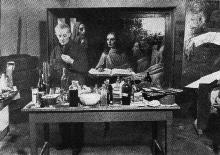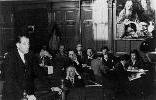 At the end of the war an unknown Vermeer, 'Christ and the Adulteress' showed up that had been purchased by Hermann Goring. Goring had actually traded about 200 paintings for it. Van Meegeren had been the first person in the chain of dealers. He was arrested after he could not give a satisfactory answer as to where the painting came from. At the end of the war an unknown Vermeer, 'Christ and the Adulteress' showed up that had been purchased by Hermann Goring. Goring had actually traded about 200 paintings for it. Van Meegeren had been the first person in the chain of dealers. He was arrested after he could not give a satisfactory answer as to where the painting came from.
 In a brilliant stroke to save himself from the charge of Nazi collaboration, he confessed to being a forger. A con man to the end, van Meegeren said to ought to be a hero because he swindled Goring and had been able to get back a lot of paintings for the Dutch people that were stolen by the Nazis.
In a brilliant stroke to save himself from the charge of Nazi collaboration, he confessed to being a forger. A con man to the end, van Meegeren said to ought to be a hero because he swindled Goring and had been able to get back a lot of paintings for the Dutch people that were stolen by the Nazis.
 Van Meegeren persuaded the police to let him paint a new Vermeer since no one could believe he was a forger. So he was locked in a room with six witnesses and a police guard. In two months
he produced a ninth painting "Young Christ" in the style of Vermeer. Van Meegeren persuaded the police to let him paint a new Vermeer since no one could believe he was a forger. So he was locked in a room with six witnesses and a police guard. In two months
he produced a ninth painting "Young Christ" in the style of Vermeer.

|





